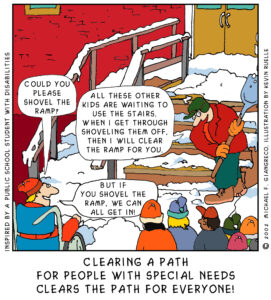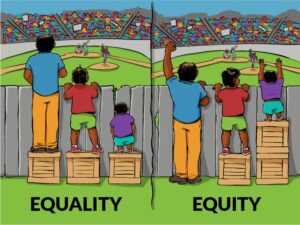Chapter 1. What is Inclusive Teaching?
Inclusive teaching is consciously, intentionally, and continuously engaging in teaching approaches that meet the needs of students across different identities, life experiences, and abilities. Inclusive teaching approaches should challenge systems of oppression that restrict access to opportunities and resources for some by naming these systems as well as changing the way these dynamics show up in their classroom. Finally, inclusive teaching includes ongoing reflection on an educator’s positionality and life experiences and how they shape their decision-making in the classroom and relationships with students. Effective inclusive teaching strategies foster a learning environment where individuals can be fully and authentically themselves and therefore thrive as students, particularly those students whose voices have historically been muted.
The words inclusivity, equality, equity and justice often are used interchangeably in conversations like these. In this toolkit, we’ll rely on these definitions:
: intentionally engaging in practices that increase accessibility of access for everyone.
In this comic below (Figure 1), inclusivity would mean clearing the ramp so that all students have access, not just a select few. Other acts of inclusivity may be more specific and might not have a direct benefit to all, but also do not perpetuate harm to any. Most inclusive acts create more engaging and welcoming spaces for all students. This might include turning on closed captioning on videos, ensuring a diversity of representation in class citations and images, or ensuring that those who need extra mobility support (e.g., use of a wheelchair) can easily navigate your classroom space.

Figure 1. “Clearing a Path” by Michael F. Giangreco, illustration by Kevin Ruelle
Copyright: InC, NC 1.0 Source URL
: equality is dividing resources equally amongst people.
Think about if you have a class of 30 people, and you have 30 cookies. Equal distribution of the cookies means each student would receive 1 cookie.
: equity is about dividing resources fairly.
Equity means factoring in people’s individual needs. For example, in a classroom where you have some students who are near-sighted, equity means reserving seats in the front of the classroom for those students.

Figure 2. Interaction Institute for Social Change | Artist: Angus Maguire
CC BY-SA 4.0 interactioninstitute.org and madewithangus.com
: Justice is about long-term equity, and about addressing systems that create barriers, not just seeing the individual as separated from their environment.
Justice is about recognizing historical, current, and potential future barriers to access and addressing these barriers to create a more equitable world.
Figure 2 helps illustrate the difference between equality, equity, and justice. The comic shows two young people attempting to gain access to the apples on a somewhat crooked apple tree. There are many ways to help the young people reach the apples. Equality gives both youth the same resources to get them closer to the top of the tree. Equity gives the youth who needs it a slightly longer ladder. Justice means that both boys can have ladders but the tree itself is also righted so that both youth can reach the apples on their ladders.
In educational spaces, a long history of inequality and exclusion both in college classrooms and in our larger national context have resulted in disparities in student access to opportunities. Righting the system will require ongoing, collaborative, intentional engagement in better more inclusive teaching strategies to ensure all students have the same opportunities to succeed. True inclusive teaching practices that take a justice approach can not be evasive about the impact of systemic oppression that has created differential access to opportunities. We hope this toolkit serves as a guide for interested educators to begin to straighten out the crooked tree to ensure equity in access for all of our students.
Check Your Understanding 1
Check Your Understanding 2
intentionally engaging in practices that increase accessibility of access for everyone
Equality is dividing sources equally
equity is about dividing resources fairly.
Justice is about long-term equity and about addressing systems that create barriers
